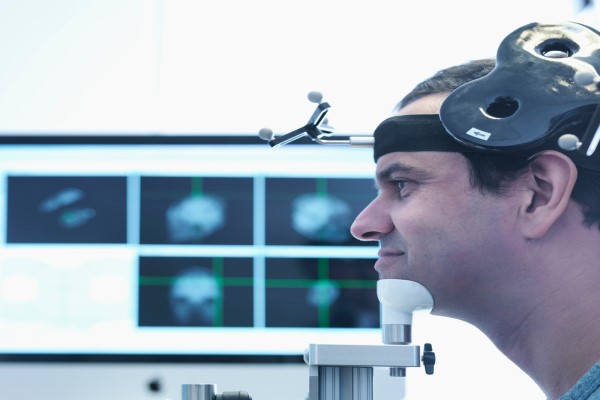Types of TMS Therapy

Transcranial magnetic stimulation therapy (TMS) is a treatment option that many mental health professionals use after counseling and medication have failed to help a patient with depression. TMS is a non-invasive procedure involving electromagnets to stimulate the patient's brain. Anyone contemplating TMS should know that psychiatrists carefully balance the procedure's advantages against any potential risks.
The different types of TMS
TMS comes in different forms, and the most commonly used ones are repetitive transcranial magnetic stimulation and deep transcranial magnetic stimulation. The two are quite distinct in terms of stimulation depth, coil type, and session time. The following is a brief overview of these two types.
Repetitive transcranial magnetic stimulation (rTMS)
Repetitive TMS is a non-invasive method that includes putting a tiny device directly on the scalp. A coil transmits electricity and produces a magnetic field in this enclosed device.
The device's electrical current activates neurons in the brain, altering their activity levels. Low neuronal activity has been connected to symptoms of mental conditions, such as obsessive-compulsive disorder (OCD). The number of rTMS sessions required is determined by the treatment protocol, which the psychiatrist will review with the patient before beginning.
According to Current Psychiatry Reports, while some studies have shown rTMS to be successful in alleviating OCD symptoms alone or in conjunction with medication, most research results show that rTMS alone is ineffective in treating OCD symptoms. It may indirectly enhance the psychological well-being of persons with OCD by lowering the symptoms of depression that often accompany OCD. According to a consensus suggestion published in the Journal of Clinical Psychiatry in 2019, rTMS may be a safe and effective therapy for patients with medication-resistant depression and considerable anxiety.
Deep transcranial magnetic stimulation (dTMS)
Deep transcranial magnetic stimulation, like rTMS, employs a coil placed over the scalp to produce a magnetic field that penetrates the brain. The most significant distinction between the two is that the H-coil used in dTMS enables the pulse to penetrate deeper into the brain.
Deep TMS has proven to be more effective than rTMS in the treatment of mental disorders. Both rTMS and dTMS have been licensed by the Food and Drug Administration (FDA) to treat severe depression. Research on its effectiveness for OCD and other mental diseases, such as bipolar disorder, is now underway.
When OCD is difficult to cure, deep TMS may provide significant results. People with treatment-resistant OCD who get dTMS often exhibit considerable improvement in their symptoms.
Uses of TMS
The FDA extended the treatment application of TMS to migraine headache symptoms in 2013 and authorized deep transcranial magnetic stimulation for the treatment of OCD in 2018. TMS may also be used to treat conditions like anxiety disorders, Alzheimer's disease, Parkinson's disease, chronic pain, schizophrenia, post-traumatic stress disorder, substance use disorder, and stroke rehabilitation.
The differences between deep TMS and repetitive TMS
The goal of deep transcranial magnetic stimulation is to energize the brain's reward and motivation systems. The subgenual anterior cingulate cortex houses the reward and motivation circuits. This spot is about four millimeters below the surface of the forehead. The intensity of the electromagnetic field must be calibrated before therapy, since the depth varies from patient to patient. Deep TMS has the features to stimulate these brain regions.
Repetitive TMS can reach depths of up to one and a half in the brain. The electromagnetic field concentrates on the dorsolateral prefrontal cortex. Deep TMS focuses on the subgenual cingulate cortex, which is farther away from the scalp.
The dorsolateral prefrontal handles executive and cognitive functions, including abstract thinking, working memory, goal-directed behavior, intent, attention management, and negative affectivity. One reasonable proposition on the probable origins of depression is that it may come from an inability to relinquish unattainable ideas or to break off from a goal-oriented mental process. These challenges relate to negative affectivity. An example would be the more unpleasant and long-lasting form of transient sadness that children feel when they have a request that is denied.
In conclusion
Health care providers should strive to deliver the most effective therapies while minimizing the patient's pain and suffering. Most providers use technology to administer dTMS and provide effective non-medication therapy for severe or treatment-resistant depression.
The effects of TMS may vary depending on the type employed and the condition being treated. For instance, current studies show that although rTMS may be successful in treating depression, it may be less effective in the treatment of OCD.
Get more information here: https://nycpsychiatricassociates.com or call NYC Psychiatric Associates at (917) 391-0076
Check out what others are saying about our services on Yelp: Read our Yelp reviews.
Related Posts
While there is no cure for many long-term behavioral disorders, they may be successfully controlled with the right combination of therapy and other treatments. Behavioral issues such as obsessive-compulsive disorder, attention deficit hyperactivity disorder, and addiction disorders are prevalent nowadays.While there has been a lot of study into what causes behavioral disorders, including diverse fields…
Depression treatment can vary from patient to patient. However, all psychiatrists approach each patient with some basic techniques. These strategies can guide you through your depression treatment. Here are the details on how each mental health provider can guide you through your condition.The psychiatrist can prescribe antidepressants. These drugs can help correct the uneven chemistry…
Professional schizophrenia treatment is necessary due to the complexity of the mental health disorder. Psychiatrists characterize it as a range of hallucinations, delusions, jumbled thinking patterns, and sometimes a loss of emotional resonance or expressiveness. These are just some of the symptoms that make trying to manage the disorder independently nearly impossible and dangerous.Before developing…
Treatment-resistant depression is a leading reason patients seek antidepressant alternatives, but it is far from the only reason. Though typically a first-line treatment, antidepressants are not the only option and are not right for every patient. The following are some reasons these drugs may not work for you and alternative therapies a psychiatrist might recommend.In…


